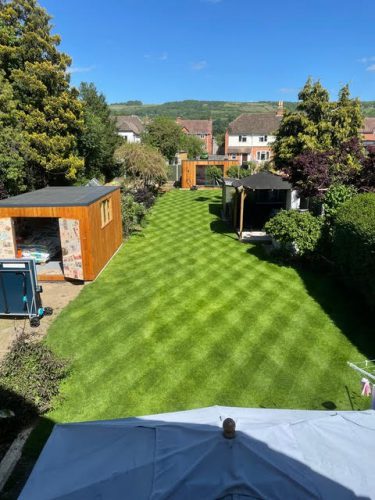At Greensleeves we think the key components that make up a perfect lawn are that it’s vibrantly green, lusciously thick and that it’s weed and moss controlled. But we also know for many people, there’s another component too –that it’s perfectly striped too!
So, with stripes on our mind, we got in touch with our resident lawn stripe expert, Andy Gregory of Greensleeves South Gloucestershire, to get some top tips on improving your lawn striping.
Ensure your lawn is healthy
The most important thing to consider is the health of your lawn, as a healthy lawn will retain those enviable stripes. Whereas a listless lawn, ridden with weeds, excess thatch, or yellow patches, won’t hold on to the stripes for as long – and obviously it also won’t look as good.
So, step one of getting those perfect stripes is ensuring your lawn is as healthy as it can be. Which, if you’re already a Greensleeves customer, you won’t need to worry about!
Get the right tools
Next, you need the right tools. The easiest way to get stripes on your lawn is with a good quality mower that has an in-built roller – this way you’ll be striping the lawn as you mow.
As Andy says: “You don’t have to have a mower with its own roller, the same effect can be achieved with a steady hand and a stiff brush. Trouble is though, that’s twice as much work, so it probably is worth investing in a roller mower.”
Frequency
Next you need to be vigilant and keep up a frequent mowing regime. In the same way that if you keep combing your hair to one side it will start to fall that way naturally, the more you reinforce your lawn’s stripes by going back over them, the more pronounced they will become.
Andy adds: “Don’t mow your lawn too short, however! Not only is that bad for it, but if the blades don’t have enough length, they won’t be able to ‘bend’ properly in order to achieve that stripe effect.”
Consider pattern
Finally, consider what type of pattern would look best on your lawn. Most people in the UK are fond of traditional striping running the length of the lawn. However, if your lawn is atypically shaped – for example if the edges bend and bow due to flower beds – you might prefer to mow your lawn in a wave pattern, embracing it’s shape. This way there are no ‘incomplete’ stripes.
Even if you have a perfectly square lawn, you still might want to mix things up, by trying different patterns, from circles to criss-cross effects. Andy says: “Personally, I am fond of the checkerboard look. You can achieve this by alternating the direction in which you mow, creating a pattern reminiscent of a game board.”
Looking for more lawn care advice?
Click here for more great Greensleeves advice on how you can keep your lawn looking tip-top.





